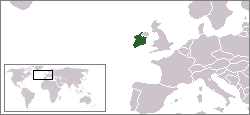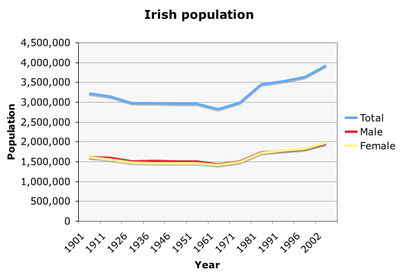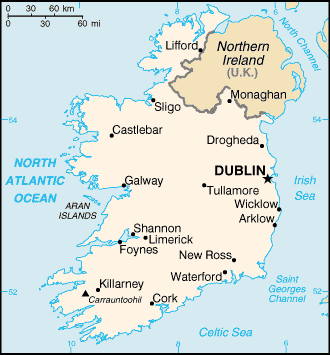Republic of Ireland
The Republic of Ireland (Irish: Poblacht na hÉireann) is a state which covers approximately five-sixths of the island of Ireland, off the coast of northwest Europe. The remaining sixth of the island of Ireland is known as Northern Ireland and is part of the United Kingdom of Great Britain and Northern Ireland.
The constitution proclaims that the state's name "is Éire or, in the English language, Ireland". The Republic of Ireland is the official description of the state, from the Republic of Ireland Act. (In this article, unless otherwise indicated, Ireland refers to the Republic of Ireland).
| ||||
| National motto (unofficial): Éire go deo (Ireland forever) | ||||
 | ||||
| Official languages | Irish, English secondary | |||
| Capital | Dublin (Baile Átha Cliath) | |||
| Largest City | Dublin | |||
| President | Mary McAleese | |||
| Taoiseach (prime minister) | Bertie Ahern, TD | |||
| Area - Total - % water | World ranking: 117th 70,273 km² 2% | |||
| Population - Total (2002) - Density | World ranking: 121st 3,917,336
56/km² | |||
| GDP - Total (2003) - GDP\capita - GDP\capita | 54th, 31st, 10th, 5th 114 Billion USD (PPP) 29,300 USD (PPP) 43,862 USD (Nominal) | |||
| Independence
- Date | Anglo-Irish Treaty
December 6, 1921 | |||
| Currency | Euro(€)¹, Irish euro coins | |||
| Time zone | WET (UTC; UTC+1 in summer) | |||
| National anthem | Amhrán na bhFiann (the Soldier's Song) | |||
| Internet TLD | .ie | |||
| Calling Code | 353 | |||
| (1) Prior to 1999: Irish pound (Punt) | ||||
History
Main articles: History of Ireland, History of the Republic of Ireland
The difference between the island of Ireland (which was once governed as a unit) and the Republic of Ireland (which covers 26 of the 32 counties on the island) is a product of complex constitutional developments in the first half of the twentieth century.
From 1 January 1801 until 6 December 1922, Ireland as one unit was part of the United Kingdom of Great Britain and Ireland. In 1919, most Irish MPs elected in the 1918 British general election declined to take their seats in the British House of Commons. Instead they set up a rival extra-legal Irish parliament called Dáil Éireann. This Dáil in January 1919 issued a Unilateral Declaration of Independence in the name of a proclaimed Irish Republic. This Declaration of Independance was mainly a restatement of the 1916 Proclamation with the additional provision that Ireland was no longer a part of the British Empire. However this, little international recognition was received despite the sending of a delegation to the Paris Peace Conference, 1919. This was mainly because of the powerful position of Britain at the conference. After a bitterly fought Anglo-Irish War (also known as the Irish War of Independence), representatives of the British government and the Irish Republic's Áireacht (cabinet) in 1921 negotiated an Anglo-Irish Treaty and gave Ireland dominion status.
The Treaty however was not entirely satisfactory to either side. It gave more concessions to the Irish than the British had intended to give but did not go far enough to satisfy fully Irish concerns. A new internationally recognised Irish state called the Irish Free State (in the Irish language Saorstát Éireann) was created. The new Free State was in theory to cover the entire island, subject to the proviso that Northern Ireland (which had been created as a separate entity under the Government of Ireland Act 1920) could opt out and choose to remain part of the United Kingdom, which it duly did. The remaining 26 counties of Ireland became the Irish Free State, a constitutional monarchy over which the British monarch reigned (from 1927 with the title King of Ireland). It had a Governor-General, a bicameral parliament, a cabinet called the Executive Council and a prime minister called the President of the Executive Council. The constitution was called the Constitution of the Irish Free State.
Civil War was the direct consequence of the creation the Irish Free State. Anti-Treaty forces, led by Eamon de Valera, objected to the fact that acceptance of the Treaty destroyed the republic of 1919 to which they had sworn loyalty to, the fact that Ireland would remain part of the British Commonwealth and the acceptance of the principle of partition of the island between the Unionist 6-county Northern Ireland and the Republican 26-county Southern Ireland. Pro-Treaty forces, led by Michael Collins, argued that the Treaty gave "not the ultimate freedom that all nations aspire and develop, but the freedom to achieve it".
At the start of the war, the Pro-Treaty National Army was out-gunned and out-manned. However, through the lack of an effective command structure of its opponents, the Irish Republican Army, and IRA units' defensive stand through out the war, Michael Collins and his commanders were able to build up an army which was able to overwhelm the IRA on the battlefield. British supplies of artillery, aircraft, machine-guns and ammunition were much help to the Pro-Treaty forces. The lack of public support for the IRA, the determination of the government to defeat the IRA and the lack of will in the IRA also contributed to the IRA's defeat.
The National Army suffered 800 fatalities and perhaps as mant as 4000 people were killed altogether. The IRA showed a major talent for destruciton as IRA units retreated and the economy of the Free State suffered a near-fatal blow in the earliest days of it's existance as a result.

On the 29 December 1937 a new constitution Bunreacht na hÉireann came into being. It replaced the Irish Free State by a new state called Éire, or, in the English language, Ireland. Though this state's constitutional structures provided for a President of Ireland instead of a king, it was not a republic. The principal key role possessed by a head of state, that of representing the state symbolically internationally remained vested in statute law in the King as an organ. On 1 April 1949 the Republic of Ireland Act declared Éire a republic, with the functions previously given to the King given instead to the President of Ireland.
Though the official name of the state remained Éire, (Article 4, "The name of the state is Éire, or in the English language, Ireland") the term Republic of Ireland (officially just the description of the new state), came to be used as its name. While the Republic chooses to use the word Ireland to describe itself, particularly in the diplomatic sphere (thus it is always the President of Ireland and the Constitution of Ireland), many states avoid using that term because of the existence of a second Ireland, Northern Ireland, and because the 1937 constitution claimed that the south had jurisdiction over the north. Using the word 'Ireland' was taken as accepting that claim and so caused offence in Northern Ireland. That claim, in what was known as Articles 2 and 3 of the 1937 constitution, was repealed in 1999.
The Irish Free State/Éire remained a member of the then British Commonwealth until the declaration of a republic in April 1949. Under Commonwealth rules declaration of a republic automatically terminates membership of the association. Only in 1950 were the rules changed to allow India as a republic to remain in the Commonwealth. Although Ireland ceased to be a member and chose not to re-apply for membership, it retained many of the privileges of Commonwealth membership. To this day, for example, Irish citizens resident in the United Kingdom enjoy all the rights of citizenship, including the right to stand for office in local and parliamentary elections and to serve in the British forces.
Ireland joined the United Nations in 1955 and the European Economic Community (now called the European Union) in 1973. Irish governments have sought the peaceful unification of Ireland and have cooperated with Britain against the violent conflict between paramilitary groups in Northern Ireland known as the Troubles. A peace settlement for Northern Ireland, known as the Belfast Agreement and approved in 1998 in a vote in both the Republic and Northern Ireland, is currently being implemented.
Politics
Main article: Politics of the Republic of Ireland
The Republic of Ireland is a republic, with a parliamentary system of government. The President of Ireland (Uachtaráin na hÉireann), who serves as head of state, is elected for a 7-year term and can be re-elected only once. The President is largely a figurehead but can still carry out certain constitutional powers and functions, aided by the Council of State, an advisory body. The prime minister, the Taoiseach, is appointed by the president on the nomination of parliament. The Taoiseach is normally the leader of the political party, or a coalition, which wins the most seats in the national elections.
The bicameral parliament, the Oireachtas, consists of a Senate, the Seanad Éireann, and a House of Representatives, the Dáil Éireann. The Seanad is composed of 60 members; 11 nominated by the Taoiseach, 6 elected by the national universities, and 43 elected from panels of candidates established on a vocational basis. The Dáil has 166 members, Teachtaí Dála or Deputies, elected to represent multi-seat constituencies under the system of proportional representation by means of the single transferable vote. Under the Irish constitution (Bunreacht na hÉireann), parliamentary elections must be held at least every 7 years, though a lower limit may be set by statute law. The current statutory maximum term is every 5 years.
The Government (Án Rialtas) is constitutionally limited to 15 members. No more than two members of the Government can be selected from the Senate, and the Taoiseach, Tánaiste (deputy prime minister) and Minister for Finance must be members of the Dáil. The current government is made up of a coalition of two parties; Fianna Fáil under Taoiseach Bertie Ahern and the Progressive Democrats under Tánaiste Mary Harney. The main opposition in the current Dáil is made up of Fine Gael and Labour. Smaller parties such as Sinn Féin and the Green Party also have representation in Dáil Éireann.
Many consider Ireland's most prominent world political figure to have been Mary Robinson, from 1997 to 2002, the United Nations High Commissioner for Human Rights.
Counties
Main article: Counties of Ireland
The Republic of Ireland is traditionally described as having 26 counties, and these continue in use in cultural, historical and sporting contexts. Dáil constituencies are required by statute to follow county boundaries, as far as possible. Hence counties with greater populations have multiple constituencies (e.g. Limerick East/West) and some constituencies consist of more than one county (e.g. Sligo-Leitrim), but by and large, the actual county boundaries are not crossed. As local government units, however, some have been restructured, with County Dublin distributed between three new county councils in the 1990s - the city "corporation" had existed previously - and County Tipperary having been administratively two separate counties since the 1890s, giving a present-day total of 30 administrative counties. In addition five cities - Dublin, Cork, Galway, Limerick, and Waterford and five boroughs - Clonmel, Drogheda, Kilkenny, Sligo and Wexford - are administered separately from the remainder of their respective counties:
Geography
Main article: Geography of Ireland

The island of Ireland extends over 84,421 km² of which five-sixths belong to the Republic, with the remainder constituting Northern Ireland. It is bound to the west by the Atlantic Ocean, to the northeast by the North Channel. To the east is found the Irish Sea which reconnects to the ocean via the southwest with St. George's Channel and the Celtic Sea. The west-coast of Ireland mostly consists of cliffs, hills and low mountains (the highest point being Carrauntoohil at 1,041 m). In from the perimeter of the country is mostly relatively flat farmland, traversed by rivers such as the River Shannon and several large lakes or loughs. The center of the country is part of the River Shannon watershed, containing large areas of bogland, used for peat production.
The local temperate climate is modified by the North Atlantic Current and relatively mild. Summers are rarely very hot, but it freezes only occasionally in winter. Precipitation is very common, with up to 275 days with rain in some parts of the country. Chief cities are the capital Dublin on the east coast, Cork in the south, Galway and Limerick on the west coast, and Waterford in the south east (see Cities in Ireland).
Economy
Main article: Economy of Ireland
The Republic of Ireland is a small, modern, trade-dependent economy with growth averaging a robust 10% in 1995-2000. Agriculture, once the most important sector, is now dwarfed by industry, which accounts for 38% of GDP, about 80% of exports, and employs 28% of the labour force. Although exports remain the primary engine for Ireland's robust growth, the economy is also benefiting from a rise in consumer spending and recovery in both construction and business investment. On paper, Ireland is the second largest software producer in the world, after the United States. In fact, a lot of foreign software, and sometimes music, is filtered through Ireland to avail of Ireland's non-taxing of royalties from copyrighted goods.
Over the past decade, the Irish government has implemented a series of national economic programs designed to curb inflation, ease tax burdens, reduce government spending as a percentage of GDP, increase labour force skills, and promote foreign investment. Ireland joined in launching the euro currency system in January 1999 along with 11 other EU nations. This period of high economic growth led many to call Ireland the Celtic Tiger. The economy felt the impact of the global economic slowdown in 2001, particularly in the high-tech export sector – the growth rate in that area was cut by nearly half. GDP growth continued to be relatively robust, with a rate of about 6% in 2001 and 2002 – but this was expected to fall to around 2% in 2003. Since 2001, GNP growth has been much worse, with an almost three-fold decrease in 2001 from the previous year. After a near stagnant year in 2002, growth was expected to pick up in 2003. [1]
Demographics
Main article: Demographics of the Republic of Ireland
Most Irish people are of Celtic ethnicity, though there is a sizable English minority. The official languages are Irish (Gaelic), the native Celtic language, and English, which is constitutionally described as a secondary official language. Learning Irish is compulsory in education, but English is by far the predominant language. Public signs are usually bilingual and national media in Irish also exist. People living in predominantly Irish speaking communities (the Gaeltacht) are limited to the low tens of thousands in isolated pockets largely on the western seaboard.
The Republic of Ireland is officially 92% Roman Catholic; however, there has been a massive decline in full adherence to Roman Catholicism among Irish Catholics. Between 1996 and 2001, regular Mass attendance, already previously in decline, declined from 60% to 48% (it had been 90%+ in 1973), and all but two of its priest-training seminaries have either closed or are expected to close soon. The Church was also hit in the 1990s by a series of sexual scandals and cover-up charges against its hierarchy. In 1995, after an approximately 58-year ban, voters chose to re-legalize divorce in the Republic.
The second largest religion, the Church of Ireland (Anglican), having been in decline for most of the twentieth century, has now experienced an increase in membership, according to the 2002 census, as have other small Christian denominations and Islam. The very small Jewish community in Ireland however has continued to decline in numbers.
Culture
Main article: Culture of Ireland
The island of Ireland has produced the Book of Kells, Guinness, Irish traditional music, and writers such as George Berkeley, James Joyce, George Bernard Shaw, Richard Brinsley Sheridan, Oliver Goldsmith, Oscar Wilde, W.B. Yeats, Samuel Beckett, Séamus Heaney, Herminie T. Kavanagh, and others. Shaw, Yeats, Beckett and Heaney are Nobel Literature laureates. Ernest Walton of Trinity College Dublin shared the 1951 Nobel Physics Prize for "splitting the atom".
Cultural figures of the late twentieth century include Christy Moore, Pat Ingoldsby, Shane MacGowan, and Sinéad O'Connor.
Successful entertainment exports in the late twentieth century included the rock group U2, Sinéad O'Connor, Bob Geldof, The Corrs and the dance show Riverdance.
Reference
- Bunreacht na hÉireann (the 1937 constitution)
- The Irish Free State Constitution Act, 1922
- J. Anthony Foley and Stephen Lalor (ed), Gill & Macmillan Annotated Constitution of Ireland (Gill & Macmillan, 1995) (ISBN 071712276X)
- FSL Lyons, Ireland Since the Famine
- Alan J. Ward, The Irish Constitutional Tradition: Responsible Government and Modern Ireland 1782-1992 (Irish Academic Press, 1994) (ISBN 0716525283)
- Some of the material in these articles comes from the CIA World Factbook 2000 and the 2003 U.S. Department of State website.
Miscellaneous topics
Main article: List of Ireland-related topics
External links
- Browse Ireland - Directory of Irish Websites
- Information on the Irish State - Governmental portal
- Áras an Uachtaráin - Official presidential site
- Tithe an Oireachtais - Houses of Parliament, official parliamentary site
- Taoiseach - Official prime ministerial site
- Ireland Story - History, geography and current affairs
- BBC country profile



